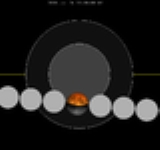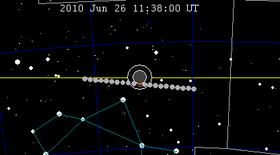
June 2010 lunar eclipse
Encyclopedia
| Partial Lunar Eclipse June 26, 2010 |
|
|---|---|
Near greatest eclipse from Canberra, Australia 11:31 UTC (Reoriented south on bottom) |
|
 This chart shows the right-to-left hourly motion of the moon through the earth's shadow. The moon inside the umbral shadow will be a subtle red, but hard to see in contrast to the much brighter moon remaining in the outer penumbral shadow. |
|
| Series (and member) Saros cycle The saros is a period of 223 synodic months , that can be used to predict eclipses of the Sun and Moon. One saros after an eclipse, the Sun, Earth, and Moon return to approximately the same relative geometry, and a nearly identical eclipse will occur, in what is referred to as an eclipse cycle... |
120 Lunar Saros 120 Saros cycle series 120 for lunar eclipses occurs at the moon's ascending node, 18 years 11 and 1/3 days. It contains 83 events.- External links :*... (58 of 84) |
| Duration (hr:mn:sc) | |
| Partial | 1:21:54 |
| Penumbral | 2:42:55 |
| Contacts | |
| P1 | 8:55:34 UTC |
| U1 | 10:16:32 UTC |
| Greatest | 11:38:29 UTC |
| U4 | 13:00:19 UTC |
| P4 | 14:21:25 UTC |
 The moon's hourly motion across the Earth's shadow in the constellation of Sagittarius Sagittarius (constellation) Sagittarius is a constellation of the zodiac, the one containing the galactic center. Its name is Latin for the archer, and its symbol is , a stylized arrow. Sagittarius is commonly represented as a centaur drawing a bow... |
|
The partial lunar eclipse of June 26, 2010 was the first of two lunar eclipse
Lunar eclipse
A lunar eclipse occurs when the Moon passes behind the Earth so that the Earth blocks the Sun's rays from striking the Moon. This can occur only when the Sun, Earth, and Moon are aligned exactly, or very closely so, with the Earth in the middle. Hence, a lunar eclipse can only occur the night of a...
s in 2010. At maximum eclipse 53.7% of the moon was covered by the earth's shadow.
This eclipse preceded by two weeks the total Solar eclipse of July 11, 2010
Solar eclipse of July 11, 2010
The total solar eclipse of July 11, 2010, occurred over the southern Pacific Ocean. -Visibility:The eclipse was one of the most remote in recorded history...
over the South Pacific.
The next total lunar eclipse, visible over North and South America, will occur six months later, on December 21, 2010
December 2010 lunar eclipse
The December 2010 lunar eclipse occurred from 5:27 to 11:06 UTC on December 21, coinciding with the date of the December solstice. It was visible in its entirety as a total lunar eclipse in North and South America, Iceland, Ireland, Britain and northern Scandinavia.-Occurrence:The eclipse of...
.
This eclipse is a part of Lunar Saros 120
Lunar Saros 120
Saros cycle series 120 for lunar eclipses occurs at the moon's ascending node, 18 years 11 and 1/3 days. It contains 83 events.- External links :*...
series, repeating every 18 years and 10 days, last occurring on June 15, 1992
June 1992 lunar eclipse
A partial lunar eclipse took place on June 15, 1992.- External links :*...
, and will next repeat on July 6, 2028
July 2028 lunar eclipse
A partial lunar eclipse will take place on July 6, 2028....
. This series is winding down: The final total eclipse of this series was on May 14, 1938 and the final partial lunar eclipse will be on July 28, 2064.
Visibility
The entire umbral phase was visible after sunset Saturday evening throughout the Pacific, New ZealandNew Zealand
New Zealand is an island country in the south-western Pacific Ocean comprising two main landmasses and numerous smaller islands. The country is situated some east of Australia across the Tasman Sea, and roughly south of the Pacific island nations of New Caledonia, Fiji, and Tonga...
, Australia
Australia
Australia , officially the Commonwealth of Australia, is a country in the Southern Hemisphere comprising the mainland of the Australian continent, the island of Tasmania, and numerous smaller islands in the Indian and Pacific Oceans. It is the world's sixth-largest country by total area...
, the Philippines
Philippines
The Philippines , officially known as the Republic of the Philippines , is a country in Southeast Asia in the western Pacific Ocean. To its north across the Luzon Strait lies Taiwan. West across the South China Sea sits Vietnam...
and Japan
Japan
Japan is an island nation in East Asia. Located in the Pacific Ocean, it lies to the east of the Sea of Japan, China, North Korea, South Korea and Russia, stretching from the Sea of Okhotsk in the north to the East China Sea and Taiwan in the south...
. The point where the moon was directly overhead at maximum eclipse lay over the South Pacific Ocean, far to the southwest of Hawaii
Hawaii
Hawaii is the newest of the 50 U.S. states , and is the only U.S. state made up entirely of islands. It is the northernmost island group in Polynesia, occupying most of an archipelago in the central Pacific Ocean, southwest of the continental United States, southeast of Japan, and northeast of...
. The lunar eclipse seen over the Philippines
Philippines
The Philippines , officially known as the Republic of the Philippines , is a country in Southeast Asia in the western Pacific Ocean. To its north across the Luzon Strait lies Taiwan. West across the South China Sea sits Vietnam...
on Saturday evening despite of rainshowers and thick clouds, but it clearly visible throughout the night sky. This photo of a lunar eclipse taken by an amateur astronomer Erika Valdueza of the Astronomical League of the Philippines (ALP).
It was seen before sunrise on Saturday morning setting over western North
North America
North America is a continent wholly within the Northern Hemisphere and almost wholly within the Western Hemisphere. It is also considered a northern subcontinent of the Americas...
and South America
South America
South America is a continent situated in the Western Hemisphere, mostly in the Southern Hemisphere, with a relatively small portion in the Northern Hemisphere. The continent is also considered a subcontinent of the Americas. It is bordered on the west by the Pacific Ocean and on the north and east...
:
| Event | PDT Pacific Time Zone The Pacific Time Zone observes standard time by subtracting eight hours from Coordinated Universal Time . The clock time in this zone is based on the mean solar time of the 120th meridian west of the Greenwich Observatory. During daylight saving time, its time offset is UTC-7.In the United States... (-7 UTC) |
MDT Mountain Time Zone The Mountain Time Zone of North America keeps time by subtracting seven hours from Coordinated Universal Time, also known as Greenwich Mean Time, during the shortest days of autumn and winter , and by subtracting six hours during daylight saving time in the spring, summer, and early autumn... (-6 UTC) |
CDT Central Time zone In North America, the Central Time Zone refers to national time zones which observe standard time by subtracting six hours from UTC , and daylight saving, or summer time by subtracting five hours... (-5 UTC) |
EDT Eastern Time Zone The Eastern Time Zone of the United States and Canada is a time zone that falls mostly along the east coast of North America. Its UTC time offset is −5 hrs during standard time and −4 hrs during daylight saving time... (-4 UTC) |
|---|---|---|---|---|
| Start penumbral (P1) | 1:55 a.m. | 2:55 a.m. | 3:55 a.m. | 4:55 a.m. |
| Start umbral (U1) | 3:17 a.m. | 4:17 a.m. | 5:17 a.m. | 6:17 a.m. |
| Greatest eclipse | 4:38 a.m. | 5:38 a.m. | 6:38 a.m. | Set |
| End umbra (U4) | 6:00 a.m. | Set | Set | Set |
| End penumbral (P4) | Set | Set | Set | Set |
 This simulation shows the view of the earth from the moon from the center of the earth at greatest eclipse. |
Lunar year (354 days)
This eclipse is the one of five lunar eclipses in a short-lived series. The lunar year series repeats after 12 lunations or 354 days (Shifting back about 10 days in sequential years). Because of the date shift, the Earth's shadow will be about 11 degrees west in sequential events.External links
- Hermit eclipse: 2010-06-26
- www.timeanddate.com: Partial Lunar Eclipse on June 26, 2010
- www.shadowandsubstance.com: Flash animation
- Lunar Eclipse Of Moon June 2010
Photos:

